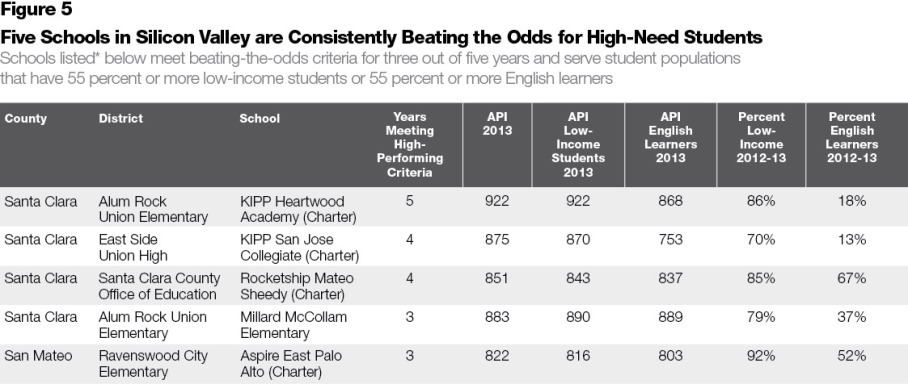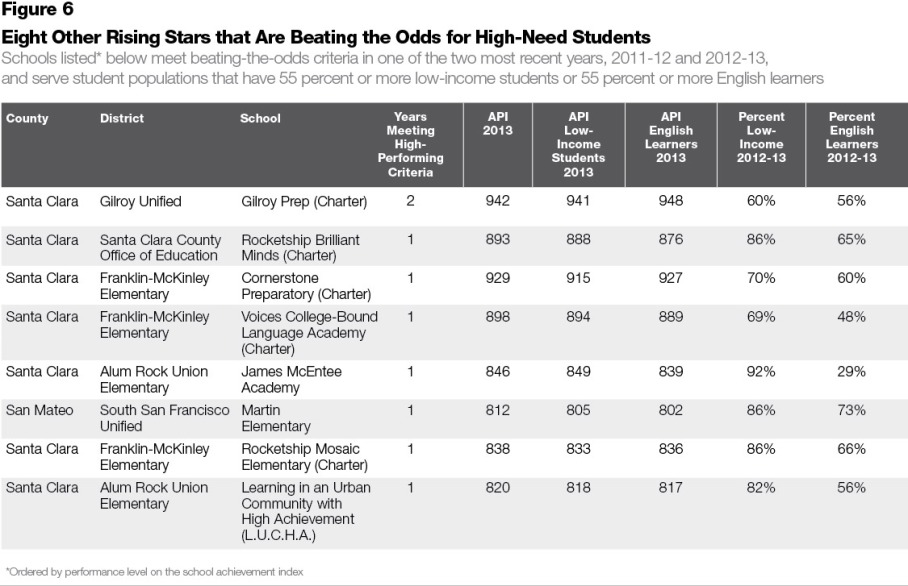Nov. 12, 2014 – Silicon Valley – More than 15,000 students in Silicon Valley are currently attending schools that have been persistently low-performing for years, according to a new report from Innovate Public Schools. “Struggling Schools, Promising Solutions” calls on local communities, especially superintendents and school boards, to take swift action to find lasting solutions for the students attending the 28 schools singled out in the report. It summarizes research from across the country on how to effectively turn around struggling schools and highlights examples of successful schools and turnaround efforts that can inform and inspire efforts in Silicon Valley.
Struggling Schools, Promising Solutions: Silicon Valley’s Lowest-Performing Schools and What Can Be Done for Students Who Attend Them
Read the parent handout about the report.
Spanish version – Versión en español
“The students at these schools deserve an excellent education that will prepare them for success in life and they can’t wait 10 years for incremental improvement. We’ve seen from schools across the country that rapid and dramatic improvement is possible. We must take bold steps to turn around these schools so that all students have the opportunity to reach their full potential,” said Matt Hammer, executive director of Innovate Public Schools. “The goal of this report is to outline steps for how we can go from where we are to where we want to be.”
Innovate identified Silicon Valley’s persistently low-performing schools based on multiple measures of school performance over a five-year period. The 28 public schools named in the list have low levels of proficiency, haven’t been improving very much for years, and also are low-performing even compared to schools around the state serving similar student populations. They are located in 13 different districts across Santa Clara and San Mateo counties and include 19 elementary schools, six middle schools, two high schools and one K-12 school.
Hopefully, the information in this report won’t be seen as a judgment against our schools, but rather a tool to generate conversation about meaningful change”, said Leon Beauchman, president of the Santa Clara County Board of Education. “We need to create a greater sense of urgency in order to ensure all students succeed.”
The report also highlights schools that are achieving very high levels of student performance while serving a majority of high-needs students, as well as what has been learned from school turnaround efforts across the country and locally. One district that has improved significantly is Alum Rock Unified School District, with three elementaries highlighted for “beating the odds”: Millard McCollam Elementary, Learning in an Urban Community with High Achievement (L.U.C.H.A), and James McEntee Elementary, which was created through a successful turnaround effort kicked off several years ago. In 2006, the district closed Lester W. Shields Elementary, a persistently low-performing school, and reopened it as two new schools (McEntee and Russo) in the same building. The district took the bold step of giving each school a new principal, almost all new teaching staff, and new curriculum.
“Effectively, the same kids were given a different school and the next year they were performing very differently because we were able to give them a different schooling, with different staff, with a different emphasis, with a focused curriculum,” said Alum Rock Superintendent Hilaria Bauer. “We knew we had to do something drastic and different that had never been tried before in the district. The focus was building the right team. I think that it gave everybody a new way of looking at schooling children. Sometimes change is important.”
“Nationwide, research shows that the issue of persistently low-performing schools disproportionately affects students from low-income backgrounds and students of color. Our report confirms that’s the case here in Silicon Valley as well,” said Jeimee Estrada, Director of Research and Policy for Innovate Public Schools.
Key Report Findings
Students at the lowest-performing schools are falling so far behind that it will become increasingly difficult for them to catch up.
Only 26 percent of students at these schools read at grade level by the third grade. In 2012-13, only 40 percent were at or above grade level as they headed from eighth grade to high school, and by the 11th grade, when students consider their college or career options, only 31 percent of students in the two high schools and the one K-12 school identified in this report were reading at grade level.
This problem is disproportionately hurting Latino and low-income students.
Of the 15,985 students who attend these 28 lowest-performing schools, 78 percent are socioeconomically disadvantaged, 81 percent are Latino, and 50 percent are English learners (EL). Some would argue that these schools’ low academic performance is simply due to the high-need populations they serve, but many schools across California prove what is possible – posting proficiency rates of 70 percent and higher, with the majority of their students being high-need.
Schools that are beating the odds show us we should set the bar far higher for both schools and students.
This report identified 122 schools in California that are beating the odds for low-income students – serving a majority of high-need students and achieving high levels of performance. Of all the high-performing schools in the state, five schools in Silicon Valley are identified as high-performing and have sustained that performance for three out of most recent five years looked at in our report. An additional eight schools in this region also meet these criteria for one or both of the two most recent years for which data are available.
Years of research and examples from across the country show that dramatic improvement is possible, but execution is key.
Over the past 10 years, much has been learned about what it takes to effectively turn around schools. Several different approaches have been shown to be effective, with these elements being common in most successful turnarounds: a culture of high expectations for all students and adults; a highly capable leader and staff; significant instructional and operational authority; and using data to identify what works.
Schools That Are Beating the Odds for High-Need Students
About Innovate Public Schools
Innovate Public Schools is a nonprofit organization whose mission is to build the parent and community demand for world-class public schools, and to accelerate the growth of these schools, particularly for low-income students and students of color. We publish easy-to-understand school quality data and research that highlights both problems and solutions, and we build the capacity of parents, community leaders and educators to innovate and act together to create world-class public schools. Learn more at www.innovateschools.org.
Media Contact:
Sierra Jenkins
310-909-6331



You must be logged in to post a comment.